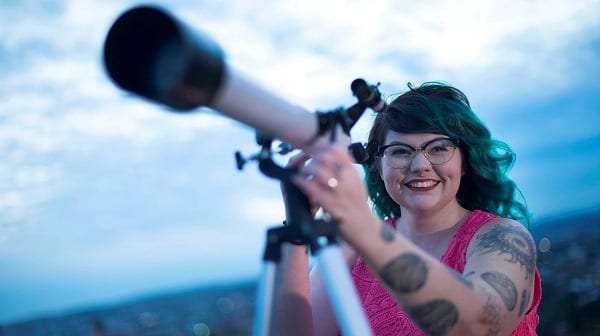Women’s Agenda is a huge fan of this event, and is supporting it once again as an online media partner by sharing insights, advice and stories from some of the awesome women involved.
When you google the words ‘famous scientist’ the results will usually produce images with some undeniable commonalities; older, white, male. If you look a bit closer, you may spot one or two women but they are still typically older and white.
Enter Karlie Noon, a young Gamileroi woman with an array of facial piercings and a vibrant sense of style, who does not conform to the aforementioned image.
The 2019 Young Australian of the Year Finalist is the first Indigenous woman in Australia to graduate with a double degree in mathematics and physics.
Karlie is using her cultural and scientific expertise to identify the traditional Aboriginal astronomical knowledge embedded within dreamtime stories. Her research highlights the richness of Indigenous cultures and the astronomy of science linked to it.
The YWCA Canberra team caught up with Karlie ahead of the She Leads Conference to discuss her journey in breaking the cycle of poverty, how the education system fails to support young Indigenous people and why we all need to support young people.
Breaking the cycle of poverty is not easy and it sounds as though your experience was filled with unique hurdles along the way. Can you outline what one of these hurdles were?
Where I grew up, a little place called Coledale, near Tamworth, there was such a significant divide within the town between people from low socio-economic backgrounds and mid socio-economic backgrounds.
There was also a clear divide within racial backgrounds, this created a lot of judgement and resulted in low expectations of Indigenous people.
Being a poor, Aboriginal kid, this definitely influenced my experience with the education system and just not being seen within it.
I had a terrible attendance rate from kindergarten right up until I left in year eight and I was never identified as a student at risk or a student that maybe needed help.
I was enabled to just coast through school without obtaining an education or any type of support that that could have helped with the struggles that I was dealing with at home.
I found the way they taught subjects like math at school to be so repetitive and disengaging, torturous really.
It’s interesting you mention that the education system made you feel as though you ‘weren’t seen’, can you tell us what helped you to combat this?
I was lucky in that respect that I was able to take education into my own hands, which you need a level of maturity to be able to do. I was provided that by my family and a friend of my grandmother who was my mentor.
She began tutoring me in math by playing fun and interactive math games more suited to my learning style. I began to become both engaged with, and very good at math.
This experience enabled me to access education outside of school. But this is not something that many people have access to.
Renee Songoro, co-founder of National Indigenous Youth Education Coalition, discusses how she believes her educational experience would have been improved if she had been exposed to an Aboriginal and or Torres Strait Islander educator. Do you think you would have felt ‘seen’ if there was Indigenous representation within your teachers?
Most definitely! Having my mentor who was Indigenous, transformed my education experience and method of learning. So yes, I think there is huge evidence of that through lived experience, for many reasons.
One of the first reasons is that you’re able to get an understanding that there are multiple ways of doing things and there are multiple knowledge systems. Also, there are different perspectives on history.
Having educators from more backgrounds, not just Aboriginal and Torres Strait Islander backgrounds can provide that. I think this can encourage meaningful and connected learning.
What advice would you give to Aboriginal and Torres Strait Islander women on their leadership journeys?
In our communities and culture often we don’t want to stand out when we’re good at something or doing well because there’s a lot of shame associated with pride.
However, there are a lot of Indigenous people in this space and a lot of young role models who are trying to address that it’s not shameful to be doing well and trying.
Trying is bettering yourself and if you can do something that your family or community can’t, don’t be ashamed of that be proud of that and do it for you, your family and your community.
If you could get one message across to the wider Australian community, what would it be?
People need to be more aware of how they treat other people, especially young people. The expectations they put on other people can impact who they can become as a person.
Particularly if you’re a teacher, an educator, a parent or a big sister etcetera. How you treat a person is incredibly influential and is how they’re going to treat themselves, so be mindful of that.
Often I don’t think kids are treated respectfully or treated as if they have rights. Currently, our kids need to grow up quickly.
They need to be making mature decisions about the future of society and the world, which is a lot more pressure compared to when I was young. So, I think we need to be giving them more respect.


